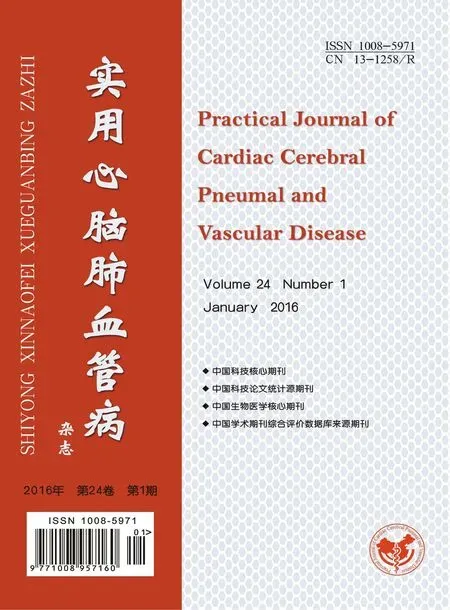血清脂蛋白相关磷脂酶A2水平与急性ST段抬高型心肌梗死患者急诊经皮冠状动脉介入术中无复流的关系研究
程 飞,李诗成,涂 昌,兰 军
523326广东省东莞市第三人民医院心内科
·论著·
血清脂蛋白相关磷脂酶A2水平与急性ST段抬高型心肌梗死患者急诊经皮冠状动脉介入术中无复流的关系研究
程 飞,李诗成,涂 昌,兰 军
523326广东省东莞市第三人民医院心内科
【摘要】目的 探讨血清脂蛋白相关磷脂酶A2(Lp-PLA2)水平与急性ST段抬高型心肌梗死(ASTEMI)患者急诊经皮冠状动脉介入(PCI)术中无复流的关系。方法连续选取2013年8月—2014年10月东莞市第三人民医院心内科收治的因ASTEMI住院并行急诊PCI的患者158例,根据急诊PCI术中无复流发生情况分为正常复流组128例和无复流组30例。比较两组患者临床资料,包括年龄、性别、吸烟情况、血压、心率、空腹血糖、低密度脂蛋白胆固醇(LDL-C)、血清Lp-PLA2水平、发病-再灌注时间、入院至球囊扩张时间(D2B)、球囊扩张次数、支架数量、支架长度、血栓抽吸情况、合并其他血管病变情况及冠状动脉〔左前降支(LAD)、右冠状动脉(RCA)、左回旋支(LCX)〕闭塞情况,采用多因素logistic回归分析筛选ASTEMI患者急诊PCI术中无复流的影响因素。结果两组患者年龄、性别、吸烟率、收缩压、舒张压、心率、空腹血糖、LDL-C、D2B、球囊扩张次数、支架数量、支架长度、血栓抽吸率、合并其他血管病变者所占比例及LAD、RCA、LCX闭塞发生率比较,差异无统计学意义(P>0.05);无复流组患者血清Lp-PLA2水平高于正常血流组、发病-再灌注时间长于正常血流组(P<0.05)。多因素logistic回归分析结果显示,血清Lp-PLA2水平〔OR=3.203,95%CI(1.734,5.919)〕、发病-再灌注时间〔OR=8.908,95%CI(3.698,21.464)〕是ASTEMI患者急诊PCI术中无复流的独立危险因素(P<0.05);校正发病-再灌注时间后,多因素logistic回归分析结果显示,血清Lp-PLA2水平是ASTEMI患者急诊PCI术中无复流的独立危险因素〔回归系数=1.160,OR=3.190,95%CI(1.955,5.204),P=0.000〕。结论血清Lp-PLA2水平是ASTEMI患者急诊PCI术中无复流的独立危险因素,早期检测血清Lp-PLA2水平可初步评估PCI术中无复流发生风险。
【关键词】心肌梗死;脂蛋白磷脂酶A2;血管成形术,气囊,冠状动脉;无复流
程飞,李诗成,涂昌,等.血清脂蛋白相关磷脂酶A2水平与急性ST段抬高型心肌梗死患者急诊经皮冠状动脉介入术中无复流的关系研究[J].实用心脑肺血管病杂志,2016,24(1):16-19,28.[www.syxnf.net]
Cheng F, Li SC,Tu C,et al.Relationship between serum Lp-PLA2 level and intra-operative no-reflow of ASTEMI patients treated by primary PCI[J].Practical Journal of Cardiac Cerebral Pneumal and Vascular Disease,2016,24(1):16-19,28.
急性ST段抬高型心肌梗死(acute ST-segment elevation myocardial infarction,ASTEMI)是冠心病的严重类型,急诊经皮冠状动脉介入(percutaneous coronary intervention,PCI)治疗ASTEMI具有冠状动脉开通率高、并发症少、病死率低等优点。随着ASTEMI急诊PCI的普及,无复流发生率增高,严重影响患者的预后,且成为心血管介入医生面临的一大难题。无复流是指接受PCI的心肌梗死患者梗死相关动脉(IRA)开通,心外膜冠状动脉闭塞解除,排除冠状动脉痉挛、栓塞、撕裂、夹层等情况,心肌组织仍存在灌注不足的现象[1-3]。出现无复流的患者再梗死、恶性心律失常、充血性心力衰竭和心源性猝死的发生率和病死率均明显升高,严重影响急诊PCI的临床疗效,因此预测无复流的发生、对无复流高危患者采取相应措施至关重要。脂蛋白相关磷脂酶A2(lipoprotein-associated phospholipase A2,Lp-PLA2)是一种炎性标志物[4],众多研究表明,Lp-PLA2水平升高与急性冠脉综合征(ACS)患者冠状动脉事件发生率增高有关[5-7]。目前有关Lp-PLA2与ASTEMI患者急诊PCI术中无复流关系的研究报道较少。本研究拟探讨血清Lp-PLA2水平与ASTEMI患者急诊PCI术中无复流的关系,旨在为无复流寻找一种有效的预测因子,进而减少无复流的发生,改善患者预后。
1资料与方法
1.1一般资料连续选择2013年8月—2014年10月东莞市第三人民医院心内科收治的因ASTEMI住院并行急诊PCI患者158例。ASTEMI诊断标准:持续胸痛时间≥30 min,含服硝酸甘油不能缓解;相邻两个或以上导联ST段弓背向上抬高:在胸导联ST段抬高≥0.2 mV和/或其他导联≥0.1 mV;血清肌酸激酶同工酶(CK-MB)和/或肌钙蛋白T升高至少1倍以上[8]。并排除合并心肌炎、心肌病、妊娠、感染、肿瘤、创伤、严重肝肾功能不全及自身免疫性疾病患者。所有患者采用Judkins法经桡动脉或股动脉途径行冠状动脉造影检查及PCI,检查结果由两位有经验的介入医师独立分析明确诊断,其中TIMI血流分级≤Ⅱ级者即可诊断为无复流。根据急诊PCI术中无复流发生情况将所有患者分为正常复流组128例和无复流组30例。
1.2TIMI血流分级0 级:无再灌注或闭塞远端无血流;Ⅰ级:部分灌注,造影剂部分通过闭塞部位,但不能使远端冠状动脉充分显影;Ⅱ级:部分再灌注或造影剂能完全充盈冠状动脉远端,但造影剂进入和清除的速度都较正常的冠状动脉慢;Ⅲ级:完全再灌注,造影剂在冠状动脉内能迅速充盈和清除。

1.4观察指标比较两组患者临床资料,包括年龄、性别、吸烟情况、血压、心率、空腹血糖、低密度脂蛋白胆固醇(LDL-C)、血清Lp-PLA2水平、发病-再灌注时间、入院至球囊扩张时间(D2B)、球囊扩张次数、支架数量、支架长度、血栓抽吸情况、合并其他血管病变情况及冠状动脉〔左前降支(LAD)、右冠状动脉(RCA)、左回旋支(LCX)〕闭塞情况。

2结果
2.1单因素分析两组患者年龄、性别、吸烟率、收缩压、舒张压、心率、空腹血糖、LDL-C、D2B、球囊扩张次数、支架数量、支架长度、血栓抽吸率、合并其他血管病变者所占比例及LAD、RCA、LCX闭塞发生率比较,差异无统计学意义(P>0.05);无复流组患者血清Lp-PLA2水平高于正常血流组、发病-再灌注时间长于正常血流组,差异有统计学意义(P<0.05,见表1)。
2.2多因素分析采用逐步筛选法最终选取Lp-PLA2、发病-再灌注时间、球囊扩张次数、支架数量、支架长度、血栓抽吸、冠状动脉闭塞部位、合并其他血管病变作为自变量(赋值见表2),将无复流作为因变量(否=0,是=1)进行多因素logistic回归分析,结果显示血清Lp-PLA2水平、发病-再灌注时间是ASTEMI患者急诊PCI术中无复流的独立危险因素(P<0.05,见表3)。校正发病-再灌注时间后,多因素logistic回归分析结果显示,血清Lp-PLA2水平是ASTEMI患者急诊PCI术中无复流的独立危险因素〔回归系数=1.160,OR=3.190,95%CI(1.955,5.204),P=0.000〕。

表2 变量赋值
表3ASTEMI患者急诊PCI术中无复流影响因素的多因素logistic回归分析
Table 3Multivariate logistic regression analysis on influencing factors of intra-operative no-reflow of ASTEMI patients treated by primary PCI

变量回归系数SEWaldχ2值OR(95%CI)P值Lp-PLA21.1640.31313.8253.203(1.734,5.919)0.000发病-再灌注时间2.1870.44923.7628.908(3.698,21.464)0.000球囊扩张次数0.0150.3910.0011.015(0.472,2.182)0.970支架数量-0.0030.5610.0001.003(0.332,2.995)0.995支架长度0.3110.3960.6191.365(0.628,2.967)0.431血栓抽吸-0.2270.7630.1311.255(0.170,3.384)0.717冠状动脉闭塞位置0.2750.6730.1671.317(0.352,4.926)0.683合并其他血管病变-0.8510.4942.9662.341(0.162,3.125)0.085
3讨论
随着冠状动脉介入技术的发展,ASTEMI患者行急诊PCI在临床逐渐得到普及,且挽救了众多患者的生命并改善了患者的预后,其已成为治疗ASTEMI的有效方法[9]。有研究显示,冠状动脉慢血流、无复流是PCI术中的严重并发症,在ACS患者行急诊PCI术中尤为常见,其发生率高达20%[10-12]。有研究显示,PCI术中出现无复流的患者易发生充血性心力衰竭、恶性心律失常和心源性猝死[3,13]。已有多个研究证实,慢血流、无复流对患者预后具有明显的负面影响,抵消了PCI带来的益处,且直接影响PCI的近期成功率[3,14]。目前,冠状动脉慢血流、无复流的发生原因和发生机制尚未完全清楚,可能与微循环内皮功能障碍有关,包括缺血损伤、再灌注损伤、远端微循环栓塞及冠状动脉微循环易损性[15]。研究显示,血栓抽吸导管的应用可明显降低PCI术中无复流发生率,尤其是高血栓负荷病变患者[16];且在溶栓失败后行补救PCI时,采用手动血栓抽吸仍能明显降低无复流发生率[17]。虽然急诊PCI术中联合血栓抽吸、冠状动脉内注射药物及提前使用他汀类药物均可有效减少无复流发生率[5,18],但仍不能完全避免无复流的发生。目前,众多学者认为针对PCI术中慢血流、无复流,预防比治疗更重要,因此如何在ASTEMI急诊PCI术前预测无复流的发生风险具有重要的临床意义。Lp-PLA2是一种炎性标志物,与氧化应激及内皮细胞功能损害有关,其是冠心病冠状动脉狭窄程度及斑块不稳定性的独立危险因素[19-20],亦是冠心病、心肌梗死后心血管事件的独立预测因子[21-22]。

表1 ASTEMI患者急诊PCI术中无复流影响因素的单因素分析
注:LDL-C=低密度脂蛋白胆固醇,Lp-PLA2=脂蛋白相关磷脂酶A2,D2B=入院至球囊扩张时间,LAD=左前降支,RCA=右冠状动脉,LCX=左回旋支;1 mm Hg=0.133 kPa;a为χ2值
本研究结果显示,血清Lp-PLA2水平、发病-再灌注时间是ASTEMI患者急诊PCI术中无复流的独立危险因素,且校正发病-再灌注时间后,多因素logistic回归分析结果仍显示,血清Lp-PLA2水平是ASTEMI患者急诊PCI术中无复流的独立危险因素,因此血清Lp-PLA2水平可作为PCI术前初步评估术中无复流的预测因素。有研究表明,球囊扩张次数、支架数量、支架长度、血栓抽吸、合并其他血管病变等可能参与ASTEMI患者急诊PCI术中无复流的发生[11,15-18],因此临床上主张对无复流高发生风险患者术中采取减少球囊扩张次数和支架数量、缩短支架长度、提前使用血管扩张剂或血小板GPⅡb/Ⅲa受体拮抗剂及血栓抽吸等措施来减少无复流的发生。但本研究结果显示,球囊扩张次数、支架数量、支架长度、血栓抽吸、合并其他血管病变与ASTEMI患者急诊PCI术中无复流的发生无关,可能与本研究所选患者在急诊PCI术中球囊预扩张次数一般不超过3次、置入支架一般不超过2个等操作习惯有关。D2B是发病-再灌注时间的一部分,应与无复流有关,但本研究结果显示,两组患者D2B间无差异,可能与本研究入选患者D2B均在1.5 h内有关。
综上所述,血清Lp-PLA2水平是ASTEMI患者急诊PCI术中无复流的独立危险因素,早期检测血清Lp-PLA2水平可初步评估PCI术中无复流的发生风险,应采取相应措施以减少无复流的发生,改善患者的预后。但由于本研究样本量较小,血清Lp-PLA2水平是否能有效预测ASTEMI患者急诊PCI术中无复流的发生,尚需临床研究进一步证实。
作者贡献:程飞、兰军进行实验设计与实施、资料收集整理、撰写论文、成文并对文章负责;程飞、涂昌、李诗成进行实验实施、评估、资料收集;兰军进行质量控制及审校。
本文无利益冲突。
参考文献
[1]Piana RN,Paik GY,Moscucci M,et al.Incidence and treatment of ′no-reflow′ after percutaneous coronary intervention[J].Circulation,1994,89(6):2514-2518.
[2]Kloner RA,Dai W.Glycoprotein Ⅱb/Ⅲa inhibitors and no-reflow[J].J Am Coll Cardiol,2004,43(2):284-286.
[3]Brosh D,Assali AR,Mager A,et al.Effect of no-reflow during primary percutaneous coronary intervention for acute myocardial infarction on six-month mortality[J].Am J Cardiol,2007,99(4):442-445.
[4]Kim JY,Hyun YJ,Jang Y,et al.Lipoprotein-associated phospholipase A2 activity is associated with coronary artery disease and markers of oxidative stress:a case-control study[J].Am J Clin Nutr,2008,88(3):630-637.
[5]Ferguson JF,Hinkle CC,Mehta NN,et al.Translational studies of lipoprotein-associated phospholipase A(2) in inflammation and atherosclerosis[J].J Am Coll Cardiol,2012,59(8):764-772.
[6]Oei HH,van der Meer IM,Hofman A,et al.Lipoprotein-associated phospholipase A2 activity is associated with risk of coronary heart disease and ischemic stroke:the Rotterdam Study[J].Circulation,2005,111(5):570-575.
[7]May HT,Horne BD,Anderson JL,et al.Lipoprotein-associated phospholipase A2 independently predicts the angiographic diagnosis of coronary artery disease and coronary death[J].Am Heart J,2006,152(5):997-1003.
[8]Galiuto L,Paraggio L,Liuzzo G,et al.Predicting the no-reflow phenomenon following successful percutaneous coronary intervention[J].Biomark Med,2010,4(3):403-420.
[9]Keeley EC,Boura JA,Grines CL.Primary angioplasty versus intravenous thrombolytic therapy for acute myocardial infarction:a quantitative review of 23 randomised trials[J].Lancet,2003,361(9351):13-20.
[10]Galiuto L,Lombardo A,Maseri A,et al.Temporal evolution and functional outcome of no reflow:sustained and spontaneously reversible patterns following successful coronary recanalisation[J].Heart,2003,89(7): 731-737.
[11]Niccoli G,Burzotta F,Galiuto L,et al.Myocardial no-reflow in humans[J].J Am Coll Cardiol,2009,54(4):281-292.
[12]Rezkalla SH,Kloner RA.Coronary no-reflow phenomenon:from the experimental laboratory to the cardiac catheterization laboratory[J].Catheter Cardiovasc Interv,2008,72(7):950-957.
[13]Bolognese L,Carrabba N,Parodi G,et al.Impact of microvascular dysfunction on left ventricular remodeling and long-term clinical outcome after primary coronary angioplasty for acute myocardial infarction[J].Circulation,2004,109(9):1121-1126.
[14]Galiuto L,Garramone B,Scarà A,et al.The extent of microvascular damage during myocardial contrast echocardiography is superior to other known indexes of post-infarct reperfusion in predicting left ventricular remodeling:results of the multicenter AMICI study[J].J Am Coll Cardiol,2008,51(5):552-559.
[15]Niccoli G,Kharbanda RK,Crea F,et al.No-reflow:again prevention is better than treatment[J].Eur Heart J, 2010,31(20):2449-2455.
[16]Ahn SG,Choi HH,Lee JH,et al.The impact of initial and residual thrombus burden on the no-reflow phenomenon in patients with ST-segment elevation myocardial infarction[J].Coron Artery Dis,2015,26(3):245-253.
[17]Boghdady A,Elbadry MI.Comparison of Successful Myocardial Reperfusion and Adverse Events in Patients With ST-Elevation Myocardial Infarction Who Underwent Rescue Percutaneous Coronary Intervention After Failed Fibrinolytic Therapy With Versus Without Manual Coronary Thrombus Aspiration[J].Am J Cardiol,2015,26(3):245-253.
[18]Zhou SS,Tian F,Chen YD,et al.Combination therapy reduces the incidence of no-reflow after primary per-cutaneous coronary intervention in patients with ST-segment elevation acute myocardial infarction[J].J Geriatr Cardiol,2015,12(2):135-142.
[19]Toth PP,McCullough PA,Wegner MS,et al.Lipoprotein-associated phospholipase A2:role in atherosclerosis and utility as a cardiovascular biomarker[J].Expert Rev Cardiovasc Ther,2010,8(3):425-438.
[20]Caslake MJ,Packard CJ,Suckling KE,et al.Lipoprotein-associated phospholipase A(2), platelet-activating factor acetylhydrolase:a potential new risk factor for coronary artery disease[J].Atherosclerosis,2000, 150(2):413-419.
[21]Maiolino G,Pedon L,Cesari M,et al.Lipoprotein-associated phospholipase A2 activity predicts cardiovascular events in high risk coronary artery disease patients[J].PLoS One,2012,7(10):e48171.
[22]Corsetti JP,Rainwater DL,Moss AJ,et al.High lipoprotein-associated phospholipase A2 is a risk factor for recurrent coronary events in postinfarction patients[J].Clin Chem,2006,52(7):1331-1338.
(本文编辑:谢武英)
Relationship Between Serum Lp-PLA2 Level and Intra-operative No-reflow of ASTEMI Patients Treated by Primary PCI
CHENGFei,LIShi-cheng,TUChang,etal.
DepartmentofCardiology,theThirdPeople′sHospitalofDongguan,Dongguan523326,China
【Abstract】ObjectiveTo explore the relationship between serum Lp-PLA2 level and intra-operative no-reflow of ASTEMI patients treated by primary PCI.MethodsA total of 158 ASTEMI patients treated by primary PCI were selected in the Third People′s Hospital of Dongguan from August 2013 to October 2014,and they were divided into A group(without intra-operative no-reflow,n=128)and B group(without intra-operative no-reflow,n=30)according to the incidence of intra-operative no-reflow.Clinical data was compared between the two groups,including age,gender,smoking status,blood pressure,heart rate,FBG,LDL-C,serum Lp-PLA2 level,duration between attack and reperfusion,duration between admission and balloon dilatation,times of balloon dilatation,number of stents,length of stents,thrombus aspiration condition,complication of other vasculopathy,occlusion situation of LAD,RCA and LCX,and multivariate logistic regression analysis was used to analyze the influencing factors of intra-operative no-reflow of ASTEMI patients treated by primary PCI.ResultsNo statistically significant differences of age,gender,smoking rate,systolic blood pressure,diastolic blood pressure,heart rate,FBG,LDL-C,duration between admission and balloon dilatation,times of balloon dilatation,number of stents,length of stents,thrombus aspiration rate,proportion of complication of other vasculopathy,occlusion rate of LAD,RCA or LCX was found between the two groups(P>0.05);while duration between attack and reperfusion of A group was statistically significantly longer than that of B group,serum Lp-PLA2 level of A group was statistically significantly higher than that of B group(P<0.05).Multivariate logistic regression analysis showed that,serum Lp-PLA2 level〔OR=3.203,95%CI(1.734,5.919)〕,duration between attack and reperfusion〔OR=8.908,95%CI(3.698,21.464)〕were independent risk factors of intra-operative no-reflow of ASTEMI patients treated by primary PCI(P<0.05);after correction of duration between attack and reperfusion,the multivariate logistic regression analysis showed that,serum Lp-PLA2 level was an independent risk factor of intra-operative no-reflow of ASTEMI patients treated by primary PCI〔B=1.160,OR=3.190,95%CI(1.955,5.204),P=0.000〕.ConclusionSerum Lp-PLA2 level is an independent risk factor of intra-operative no-reflow of ASTEMI patients treated by primary PCI,early detection of serum Lp-PLA2 level is helpful to evaluate the risk of intra-operative no-reflow of ASTEMI patients treated by primary PCI.
【Key words】Myocardial infarction;Lipoprotein-associated phospholipase A2;Angioplasty,balloon,coronary;No-reflow
(收稿日期:2015-10-23;修回日期:2016-01-14)
【中图分类号】R 542.22
【文献标识码】A
doi:10.3969/j.issn.1008-5971.2016.01.005
通信作者:兰军,523326广东省东莞市第三人民医院心内科;E-mail:mdcf2006@126.com

